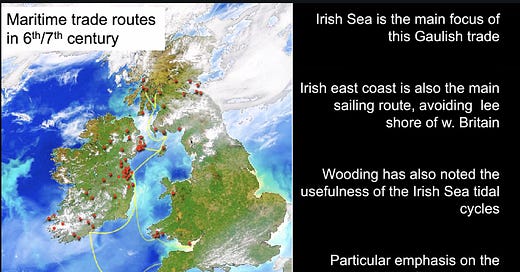While I feel so connected to the character of Erna I am developing and to the landscape of the story—some of which I literally walked daily into my being during my own time in Argyll—I have been struggling with my understanding of what the daily world was like. I am imagining a young girl growing into a brilliant scribe at the same time that one of the most storied centres of Christianity was literally being constructed around her. I have one of those brains that even if I don’t tell you everything I need to understand it before I can move forward. In the scriptorium on Iona where does the vellum come from? Who brings it? What do they trade for? Where does all the money for a new monastery come from? And even though I have to make so much of it up, I really crave to unleash my imagination from the realities of what we do know.
This desire has led me to so much fun! I find learning fun. Writing this book might turn out to be my version of a Masters and that delights me! (May we all have time and safety to learn wonderful things). In my curiosity I have found some of the most brilliant and generous organizations who host zoom talks on all sorts of topics of archeology and history. It’s truly been one of the most powerful research tools I could have encountered. Many of them have fabulous archives to visit too. I started with the wonderful Kilmartin Museum that does both live evening talks and curates a vibrant Youtube channel of the archive.
Recently though I attended one of the best “world making” talks for the period that I’ve ever encountered. The talk was offered by Tuatha which is a fabulous organization that is run by Irish archeologists and historians with education and tourism in mind. Their weekly “Monument Monday” newsletter has been so helpful to me in gathering more fragments of the story. The links between Argyll and Ireland are so strong during the period of our story so I knew that I might be able to gather some peripherals.
I have 40 screen shots!!
Professor Aidan O’Sulivan, University College Dublin, gave a brilliant presentation called “The Archeology of Trade in early Medieval Ireland.” But it was so much more than that. He gathered information about trade routes, the tides in the Irish Sea, the goods that would have been traded, the roles of animals and goods that were part of people’s lives, quotes about the normalcy of Irish butter in medieval Italy, visuals of the ships that would have been coming into port, how small islands served as safe landing spots for traders and that warehouses were most likely tented type structures for receiving and dispensing freight safely and in quick order. He invited us into the role of the monasteries and the mariners themselves in directing and distributing trade. I was completely lost in the world while he spoke and for the first time could see how Colmcille (St Columba) could have arrived on the windswept Iona with the conceit that he was capable of building a centre of regional importance there. It wasn’t just his faith. He had already inhabited such places as a rich and important person. He had contacts. The boats were already going by! He didn’t go to a wild unknown as the legends would have us believe. He created a new stop on an existing route.
There are always invisible people behind history’s magical accomplishments!
And that is what makes the story of my 6th century erased saint so powerful to me.
Onwards!
Susie




